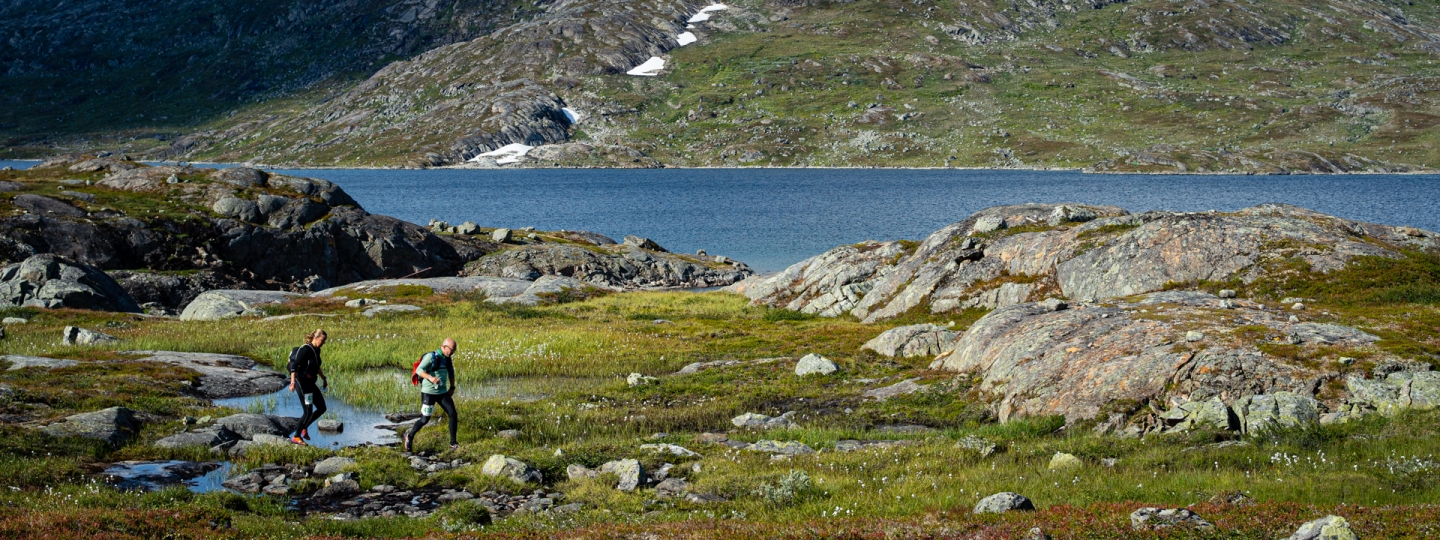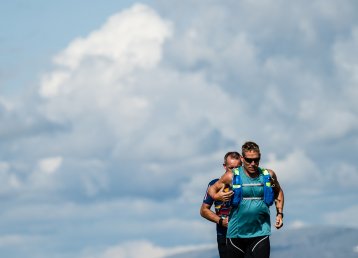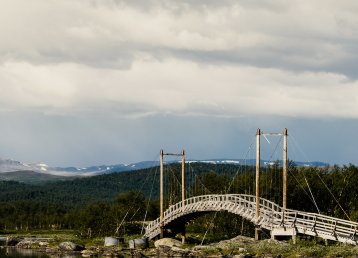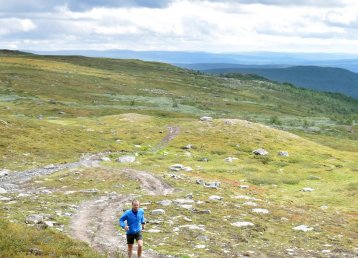Exclamations, ranging from primal screams to whoops of joy bounce between mountainsides somewhere in the very north of Sweden. This is the setting for BAMM – Björkliden Arctic Mountain Marathon – a competition making its mark as one of Scandinavia’s greatest physical challenges in running shoes these last 30 years.
— It hurts when you run long distances in the mountains, of course, says Erik Ahlström, but not in the same way as when you’re running a race on the tarmac. People laugh and have fun here, even when it’s hard work.
Erik Ahlström, a ski alpinist, multi-sport icon and mountain-marathon profile, is one of the main reasons why interest in trail running has virtually exploded in Sweden. I ask him why. He scratches his chin and says:
— It’s contradictory, isn’t it? We’ve never had it so good, and yet we’ve never felt so bad. One of the reasons is that we don’t spend enough time in nature – and trail running is an amazing way of getting back on your feet.
We will return to Erik later on.
Not even fun
We are in Riksgränsen, in the Kiruna mountain world, with Norway only a few hundred metres away. The landscape here is unforgiving and harsh, summers are short, and plants and animals have adapted to extreme conditions.
One of those shouts from before belongs to Jessica. She lies on her back with arms and legs spread out, looking a lot like someone who has had a proper crash landing. She has fallen over just metres from the last orienteering checkpoint of the day. Her chest rises sharply as a result of all the height metres she and her husband Pär have just left behind.
— Damn it, she gasps. This isn’t even funny.
— But now we’re at the finish line, Pär says.
— And tomorrow we’ll get just as far, he smiles.
Jessica sighs audibly and says:
— Let’s focus on the positive.
She rolls herself around and places the small electronic clip against the checkpoint. It bleeps to confirm that they have reached today’s finish line. Night camp awaits with crisps and Chilli con Carne.
— But still, she laughs, this is absolutely fantastic.
As long as we can remember
The thing about running long distances is nothing new, obviously. Humans have done it for a long time. At least since the soldier Pheidippides, entered the history books running his legendary 42,195 metres from Marathon to Athens to deliver news about victory. The year was 490 BC, and no one bothered with things like Vibram soles, toe box and Gore-Tex. Apart from technical achievements, the difference 2,000 years later is how it is done – these days it is called trail running, and you do it because you feel like it.
— Trail running is not so much about making it first across the finish line, says Tessa Brandt, a Dutch trail runner who has just completed 51 kilometres on trails far beyond her wildest imagination. The competition Tessa has just managed to finish is called Arctic Circle Trails and is arranged in the mountains around Arjeplog.
— You really have to keep track of where you put your feet, she laughs. It means looking down a lot while you’re running, and as soon as you’re able to look up, the impression is that of being in a completely different world. As if you were running on the moon.
That is the very experience, says Tessa, the reason why she – and just about every other runner there is – loves this.
— Trail running takes you to places you would never have visited, and lets you experience things you would never have done otherwise.

Trail running
Trail running is not so much about making it first across the finish line, it's more about experience places you would never have visited.
Beyond the end of the world
Bas Heres is one of the organisers behind Arctic Circle Trails. This is the first year he and his colleague Koen van Hess, both from the Netherlands, organise a running party in Swedish Lapland.
— Many participants say this is the best trail run of their lives, says Bas, smiles and explains that he is not really that surprised:
— The environment here is perfect. The landscape is magnificent, and the trails just the right technical level. The trail systems, with the King’s Trail as the brightest shining star, are ideally suited for trail running. Maintenance is usually spot on and if it’s a bit lacking – well, the flaws become part of the adventure.
— The fact that we also fly the runners out by helicopter or take them by boat to the middle of nowhere obviously helps make it an even more amazing experience, Koen concludes.
Helicopter transfer might sound a bit grand for an otherwise modest sport. Still, Bas explains that they want to create the feeling that the participants, who mostly live in urban areas in the Netherlands, have come to the end of the world when they arrive in Arjeplog.
— And from there we continue even further into something they’ve never experienced before.
The competition consists of two races in two days, 51 kilometres in total, with a day of rest in between.
— It’s all about creating a unique experience above the Arctic Circle. That’s why we also use boat transfers and a number of meetings with local traditions and Arctic culture, Koen says.
Also read
The king of all trailsArctic Circle Trails
Arctic Circle Trails is a Dutch event organised by Bas Heres and Koen van Hess, in the Arjeplog mountains. Learn more about the event at arcticcircletrails.org.
From the beginning
Erik Ahlström paces back and forth in the finish area in Riksgränsen. He is waiting to welcome the first runner of the year across the finish line. He is a veteran of the running and multi-sport scene. Among other things, he was one of the founders of BAMM more than 30 years ago, a concept also known under acronyms such as FEM, BIMM and RAT. In those days, Erik had just completed his studies in tourist sport in Kiruna and was the newly appointed marketing manager at Björkliden.
— Before that, I was in the Alps, but I broke my ankle and found myself in a hospital bed. To make a long story short, I ended up studying tourism sport in Kiruna.
The first thing Erik did when he came up north was to climb Kebnekaise, Sweden’s highest mountain. He was enthralled.
— Who knew there were such cool mountains in Sweden, I thought as I stood on the southern peak. How come there are no adventure races here?
While he was still studying Erik started Kebnekaise Classic. A two-day competition in winter, spending the night in bivouacs in the snow. The arrangement showed a little of what he was capable of and opened the door to that job as a marketing manager in Björkliden.
— It was there, and then we started the mountain marathon.
It went quite well from the beginning, with around 15 teams on the starting line the first year.
— We also got 12 pages in the magazine Jogging, now called Runners World, with fantastic mountain photos.
The interest in BAMM skyrocketed, and the following year everyone was talking about that new competition in Björkliden.
– That’s more or less, how it went. We’ve added a bit more orienteering over the years, but apart from that, the concept has always been pretty much the same.
Running with experiences
Today, BAMM has four classes. You run 10, 30, 50 or 70 kilometres. As the crow flies, that is. If you make a mistake when orienteering, chances are you will run farther. Sometimes a lot farther. BAMM is also a competition with two-person teams. The fact that you run with a team member is something Erik thinks has contributed to its popularity.
—It’s a breath-taking feeling, getting to the top of a mountain, looking out across the other side. There is a depth in that experience, facing the views. You might want to share that with someone.
In Riksgränsen Jenny Sjöström, a teacher from the small mountain village Ammarnäs has arrived at night camp, located on a peninsula at the southeast end of Lake Gátterjávri. With company.
Yes, BAMM is a two-day competition. In the 70-km class, you carry food, tent, spare clothes – everything you need to cope in severe weather conditions on the mountain, in your backpack. In the 30- and 50-km classes, you can have your equipment sent to the night camp these days— a perfect way of enabling more people to participate.
— It’s definitely great having made it here, Jenny gasps.
— The idea is to be self-sufficient for two days, says Erik. There is a lot of tactics involved.
The atmosphere in the night camp is magical. A low, late-summer sun warms tired muscles. Water is boiled on camping stoves and poured over freeze-dried food. The conversation is flowing. Route choices are evaluated, and so are slips and scratches. Aching feet and small ailments get relief. Everything is just as it should be.
— When I’m stood there on the starting line, Jenny laughs, I think “why can’t I just settle for being sat at home on the sofa?”
She is rewarded with cordial and cinnamon buns by the organisers.
— But look at what you’re actually capable of, she says. Quite a lot, really.
Yes, a lot more than you’d think.
BAMM
Björkliden Arctic Mountain Marathon – or ‘BAMM’ – is a 70-kilometre long demanding mountain orienteering race that spans over two days. Learn more about the race at bjorkliden.com.
On your own or extreme running
Competition is not a must if you want to appreciate the mountains in running shoes. Erik says that he likes to run between the STF huts in the mountains, carrying a light day backpack. It benefits his creativity.
—You know, running in these environments you get to work all your senses. It’s incredibly rewarding.
Erik says he has never liked carrying big, heavy backpacks.
—But since you can run a lot further in one day, you don’t need the same amount of equipment.
It might sound contradictory but running in the mountains can in some ways be easier than hiking. You can make it extreme if you want to, of course. Like the phenomenon Emilie Forsberg did, the Ultrarunning and Sky running world champion. The other year she ran the King’s Trail a lot faster than anyone had ever done before. It took Emilie 4 days and 21 hours to run 450 kilometres between Hemavan and Abisko. A distance that hikers usually spend at least 15 days on. The following year Max Själlin ran the same route seven hours faster. No one has really found the limit yet.
Speaking of limits, in Riksgränsen Jessica and Pär have made it across the finish line.
—It was hard work today, Pär says. We got exhausted.
— Perhaps because our bodies had already been running for a day?
— But I think we ran more today, even if the orienteering might have been a little easier.
— There was a lot of climbing too.
— But it’s nice to have made it to the finish line.
Then they head for the shower. And later the celebration banquet that awaits.

Make the impossible possible
— It doesn’t matter what place you get, what matters is being able to do something you never thought was possible, says Jenny who has also reached the finish line in Riksgränsen.
Erik gives her an encouraging pat on the shoulder and says, a bit to himself:
— It’s surprising how mighty the mountains are. How grand it is up here. And the light. It feels like infinity in so many different ways.
People need the mountains, for sure, Erik says as well as the challenges that come with spending time in them.
— We’ve got this idea that hurting is dangerous. Things mustn’t hurt these days, he says, shaking his head lightly. But that’s how we learn. That’s how we’ve always learned.
Tessa Brandt from the Netherlands is sat on a large rock by Hornavan, Sweden’s deepest lake. The surface is like a mirror, and the sun is shining, even if it is near midnight. She has definitely felt more energetic than she does right now. But she is happy. She says that trail running has become a natural part of her life – training for a competition as well as the competition itself.
– It’s easy to become addicted to all this, she says, looking at the mountains as they bask in the evening light.
It is indeed difficult not to agree.


































